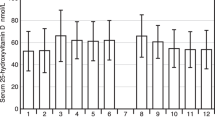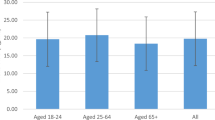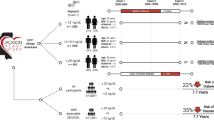Abstract
Background:
Vitamin D deficiency is common worldwide. No homogenous reference values have yet been established and no studies of values have been conducted in Spain involving a large number of participants.
Objective:
To study the population concentrations of vitamin D in a representative sample of the Spanish population.
Subjects/Methods:
The study involved two cohorts from Spain, the Asturias study and the Pizarra study, which are two prospective, population-based studies involving 2260 participants. In 1262 subjects (age: 20–83 years) we studied 25-hydroxyvitamin D, intact parathyroid hormone (iPTH), calcium, phosphorus and creatinine.
Results:
The median population values of 25-hydroxyvitamin D and iPTH were 22.46 ng/ml and 42.29 pg/ml, respectively. The values of 25-hydroxyvitamin D were significantly higher in summer and correlated with age (β=−0.05±0.01, P<0.0001), creatinine (β=6.42±1.17, P<0.0001) and iPTH (−0.07±0.01, P<0.0001), but not with calcium, phosphorus or sex. The increase in iPTH with age was seen whatever the values of 25-hydroxyvitamin D, and was greater in the older persons. The concentration of iPTH rose continuously with effect from 25-hydroxyvitamin D values below ≈30 ng/ml. Values above ≈35 ng/ml were associated with a significantly lower concentration of iPTH.
Conclusions:
One-third (33.9%) of the Spanish population may be at risk for Vitamin D deficiency. The 25-hydroxyvitamin D values above 30 ng/ml can safely discard ‘hyper PTH’. The increase in iPTH concentration is greater in older persons for similar values of 25-hydroxyvitamin D.
This is a preview of subscription content, access via your institution
Access options
Subscribe to this journal
Receive 12 print issues and online access
$259.00 per year
only $21.58 per issue
Buy this article
- Purchase on Springer Link
- Instant access to full article PDF
Prices may be subject to local taxes which are calculated during checkout




Similar content being viewed by others
References
Adami S, Bertoldo F, Braga V, Fracassi E, Gatti D, Gandolini G et al. (2009). 25-hydroxy vitamin D levels in healthy premenopausal women: association with bone turnover markers and bone mineral density. Bone 45, 423–426.
Annweiler C, Beauchet O, Berrut G, Fantino B, Bonnefoy M, Herrmann FR (2009). Is there an association between serum 25-hydroxyvitamin D concentration and muscle strength among older women? Results from baseline assessment of the EPIDOS study. J Nutr Health Aging 13, 90–95.
Arabi A, Baddoura R, El-Rassi R, Fuleihan G (2010). Age but not gender modulates the relationship between PTH and vitamin D. Bone 47, 408–412.
Bhutto A, Morley JE (2008). The clinical significance of gastrointestinal changes with aging. Curr Opin Clin Nutr Metab Care 11, 651–660.
Boüüaert C, Vanmeerbeek M, Burette P, Cavalier E, Seidel L, Blockx S et al. (2008). Vitamin D deficiency in elderly men living in urban areas, at home or in institutions. Presse Med 37, 191–200.
Calatayud M, Jódar E, Sánchez R, Guadalix S, Hawkins F (2009). Prevalencia de concentraciones deficientes e insuficientes de vitamina D en una población joven y sana. Endocrinología y Nutrición 56, 164–169.
Carnevale V, Modoni S, Pileri M, Di Giorgio A, Chiodini I, Minisola S et al. (2001). Longitudinal evaluation of vitamin D status in healthy subjects from southern Italy: seasonal and gender differences. Osteoporos Int 12, 1026–1030.
Craver L, Marco MP, Martínez I, Rue M, Borràs M, Martín ML et al. (2007). Mineral metabolism parameters throughout chronic kidney disease stages 1-5--achievement of K/DOQI target ranges. Nephrol Dial Transplant 22, 1171–1176.
Chapuy MC, Preziosi P, Maamer M, Arnaud S, Galan P, Hercberg S et al. (1997). Prevalence of vitamin D insufficiency in an adult normal population. Osteoporos Int 7, 439–443.
Christensen M, Lien E, Hustad S, Almas B (2010). Seasonal and age-related differences in serum 25-hydroxyvitamin D, 1, 25-dihydroxyvitamin D and parathyroid hormone in patients from Western Norway. Scand J Clin Lab Invest 70, 281–286.
Dusso AS, Brown AJ, Slatopolsky E (2005). Vitamin D. Am J Physiol Renal Physiol 289, 8–28.
Gómez-Alonso C, Naves-Díaz ML, Fernández-Martín JL, Díaz-López JB, Fernández-Coto MT, Cannata-Andía JB (2003). Vitamin D status and secondary hyperparathyroidism: the importance of 25-hydroxyvitamin D cut-off levels. Kidney Int 63, S44–S48.
Gonzalez Solanellas M, Romagosa Pérez-Portabella A, Zabaleta del Olmo E, Gudiña Escudero N, Pozo Díaz C, Moreno Feliu R et al. (2008). Vitamin D deficiency in women of reproductive age. Atenc Primaria 40, 393–399.
Harris SS, Soteriades E, Coolidge JA, Mudgal S, Dawson-Hughes B (2000). Vitamin D insufficiency and hyperparathyroidism in a low income, multiracial, elderly population. J Clin Endocrinol Metab 85, 4125–4130.
Heaney RP (2000). Vitamin D: how much do we need, and how much is too much? Osteoporos Int 11, 553–555.
Henry HL, Bouillon R, Norman AW, Gallagher JC, Lips P, Heaney RP et al. (2010). 14th Vitamin D Workshop consensus on vitamin D nutritional guidelines. J Steroid Biochem Mol Biol 121, 4–6.
Hintzpeter B, Mensink GB, Thierfelder W, Muller MJ, Scheidt-Nave C (2008a). Vitamin D status and health correlates among German adults. Eur J Clin Nutr 62, 1079–1089.
Hintzpeter B, Scheidt-Nave C, Muller MJ, Schenk L, Mensink GB (2008b). Higher prevalence of vitamin D deficiency is associated with immigrant background among children and adolescents in Germany. J Nutr 138, 1482–1490.
Ho-Pham LT, Nguyen ND, Lai TQ, Eisman JA, Nguyen TV (2010). Vitamin D status and parathyroid hormone in a urban population in Vietnam. Osteoporos Int, E-pub ahead of print; doi:10.1007/s00198-010-1207-4.
Holick MF (2007). Vitamin D Deficiency. N Engl J Med 357, 266–281.
Holick MF (2010). Vitamin D: extraskeletal health. Endocrinol Metab Clin North Am 39, 381–400.
Hyppönen E, Power C (2007). Hypovitaminosis D in British adults at age 45 year nationwide cohort study of dietary and lifestyle predictors. Am J Clin Nutr 85, 860–868.
Isaia G, Giorgino R, Rini GB, Bevilacqua M, Maugeri D, Adami S (2003). Prevalence of hypovitaminosis D in elderly women in Italy: clinical consequences and risk factors. Osteoporos Int 14, 577–582.
Jacques PF, Felson DT, Tucker KL, Mahnken B, Wilson PW, Rosenberg IH et al. (1997). Plasma 25-hydroxyvitamin D and its determinants in an elderly population sample. Am J Clin Nutr 66, 929–936.
Khosla S, Atkinson EJ, Melton LJ, Riggs BL (1997). Effects of age and estrogen status on serum parathyroid hormone levels and biochemical markers of bone turnover in women: a population-based study. J Clin Endocrinol Metab 82, 1522–1527.
LaClair RE, Hellman RN, Karp SL, Kraus M, Ofner S, Li Q et al. (2005). Prevalence of calcidiol deficiency in CKD: a cross-sectional study across latitudes in the United States. Am J Kidney Dis 45, 1026–1033.
LeBoff MS, Kohlmeier L, Hurwitz S, Franklin J, Wright J, Glowacki J (1999). Occult vitamin D deficiency in postmenopausal US women with acute hip fracture. JAMA 281, 1505–1511.
Lips P (2010). Worldwide status of vitamin D nutrition. J Steroid Biochem Mol Biol 121, 297–300.
MacLaughlin J, Holick MF (1985). Aging decreases the capacity of human skin to produce vitamin D3. J Clin Invest 76, 1536–1539.
Maeda S, Kunii I, Hayashi L, Lazaretti-Castro M (2010). Increases in summer serum 25-hydroxyvitamin D (25OHD) concentrations in elderly subjects in Sao Paulo, Brazil vary with age, gender and ethnicity. BMC Endocr Disord 14, 10–12.
Malabanan A, Veronikis IE, Holick MF (1998). Redefining vitamin D insufficiency. Lancet 351, 805–806.
Mata-Granados JM, Luque de Castro MD, Quesada JM (2008). Inappropriate serum levels of retinol, α-tocopherol, 25 hydroxyvitamin D3 and 24, 25 dihydroxyvitamin D3 levels in healthy Spanish adults: simultaneous assessment by HPLC. Clin Biochem 41, 676–680.
Mehrotra R, Kermah D, Budoff M, Salusky IB, Mao SS, Gao YL et al. (2008). Hypovitaminosis D in chronic kidney disease. Clin J Am Soc Nephrol 3, 1144–1151.
Mezquita-Raya P, Munoz-Torres M, Luna JD, Luna V, Lopez-Rodriguez F, Torres-Vela E et al. (2001). Relation between vitamin D insufficiency, bone density, and bone metabolism in healthy postmenopausal women. J Bone Miner Res 16, 1408–1415.
Niño Martín V, Pérez Castrillón JL (2008). Niveles de vitamina D en población mayor de 65 años. Revista Española de Enfermedades Metabólicas Óseas 17, 11–14.
Pattanaungkul S, Riggs BL, Yergey AL, Vieira NE, O’Fallon WM, Khosla S (2000). Relationship of intestinal calcium absorption to 1, 25-dihydroxyvitamin D [1,25(OH)2D] levels in young versus elderly women: evidence for age related intestinal resistance to 1, 25(OH)2D action. J Clin Endocrinol Metab 85, 4023–4027.
Pérez-Llamas F, López-Contreras MJ, Blanco MJ, López-Azorín F, Zamora S, Moreiras O (2008). Seemingly paradoxical seasonal influences on vitamin D status in nursing-home elderly people from a Mediterranean area. Nutrition 24, 414–420.
Rodríguez Sangrador M, Beltrán de Miguel B, Quintanilla Murillas L, Cuadrado Vives C, Moreiras Tuny O (2008). The contribution of diet and sun exposure to the nutritional status of vitamin D in elderly Spanish women: the five countries study (OPTIFORD Project)]. Nutr Hosp 23, 567–576.
Soriguer F, Esteva I, Rojo-Martinez G, Ruiz de Adana S, Catalá M, Merelo MJ et al. (2002). Prevalence of diabetes mellitus type LADA in South Spain. Diabetes Res Clin Pract 56, 213–220.
Soriguer F, Rojo-Martínez G, Almaraz MC, Esteva I, Ruiz de Adana MS, Morcillo S et al. (2008). Incidence of type 2 diabetes in southern Spain (Pizarra study). Eur J Clin Invest 38, 126–133.
Tangpricha V, Pearce EN, Chen TC, Holick MF (2002). Vitamin D insufficiency among free-living healthy young adults. Am J Med 112, 659–662.
Thomas KK, Lloyd-Jones DH, Thadhani RI, Shaw AC, Deraska DJ, Kitch BT et al. (1998). Hypovitaminosis D in medical inpatients. N Engl J Med 338, 777–783.
Valdés S, Botas P, Delgado E, Alvarez F, Cadórniga FD (2007). Population-based incidence of type 2 diabetes in northern Spain: the Asturias Study. Diabetes Care 30, 2258–2263.
Vaquero MP, Sánchez-Muniz FJ, Carvajal A, García-Linares MC, García-Fernández MC, García-Arias MT (2004). Mineral and vitamin status in elderly persons from northwest Spain consuming an Atlantic variant of the Mediterranean diet. Ann Nutr Metab 48, 125–133.
Vieth R, Ladak Y, Walfish P (2003). Age-related changes in the 25-hydroxyvitamin D versus parathyroid hormone relationship suggest a different reason why older adults require more vitamin D. J Clin Endocrinol Metab 88, 185–191.
von Mühlen DG, Greendale GA, Garland CF (2005). Vitamin D, parathyroid hormone levels and bone mineral density in community-dwelling older women: The Rancho Bernardo Study. Osteoporos Int 16, 1721–1726.
Zittermann A, von Helden R, Grant WB, Kipshoven C, Ringe JD (2009). An estimate of the survival benefit of improving vitamin D status in the adult German population. Derm Endocrinol 1, 119–120.
Acknowledgements
This study was conducted with finance from the Fondo de Investigacion Sanitaria (PIO51307) and Junta de Andalucía (PIO258/2007, P06-CTS-01684) CIBER de Diabetes y Enfermedades metabólicas is an ISCII project.
Author information
Authors and Affiliations
Corresponding author
Ethics declarations
Competing interests
The authors declare no conflict of interest.
Rights and permissions
About this article
Cite this article
González-Molero, I., Morcillo, S., Valdés, S. et al. Vitamin D deficiency in Spain: a population-based cohort study. Eur J Clin Nutr 65, 321–328 (2011). https://doi.org/10.1038/ejcn.2010.265
Received:
Revised:
Accepted:
Published:
Issue Date:
DOI: https://doi.org/10.1038/ejcn.2010.265
Keywords
This article is cited by
-
Real world evidence of calcifediol or vitamin D prescription and mortality rate of COVID-19 in a retrospective cohort of hospitalized Andalusian patients
Scientific Reports (2021)
-
Can climatic factors explain the differences in COVID-19 incidence and severity across the Spanish regions?: An ecological study
Environmental Health (2020)
-
Evidence for possible association of vitamin D status with cytokine storm and unregulated inflammation in COVID-19 patients
Aging Clinical and Experimental Research (2020)
-
Seasonal periodicity of serum parathyroid hormone and its relation with vitamin D in Romania
Archives of Osteoporosis (2020)
-
Osteopenia and Osteoporosis in Patients with Bronchiectasis: Association with Respiratory Parameters, Body Composition, Muscle Strength and Bone Remodeling Biomarkers
Scientific Reports (2019)



